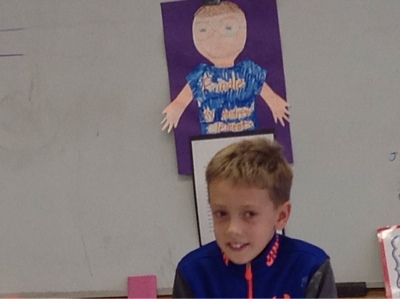Enrichment Homework
Here we see Bob showing his seed collection. You know they come in all different sizes and colors.

What would I do if I was the teacher?
One thing Matthew would do is have a class pet. He also thinks one hour of recess would be perfect!
Project Based Learning
The first thing we had to do was choose a book and character to focus on. So, we went on a little field trip to our school library. Mrs. DeFrank helped us to find realistic fiction stories at our reading levels and interests. Then each child got to pick a just right book.
Each day, after a mini lesson around one of the following: character traits, story elements, note taking strategies or comprehension strategies, students worked on their individual projects. During this time we focused on the standards below.
Reading: Literature
Key Ideas and Details
3. Describe characters in a story (e.g., their traits, motivations, or feelings) and explain how their actions contribute to the sequence of events.
Corresponding College and Career Readiness (CCR) Anchor Standard
3. Analyze how and why individuals, events, and ideas develop and interact over the course of a text.
Note on range and content of student reading
To build a foundation for college and career readiness, students must read widely and deeply from among a broad range of high-quality, increasingly challenging literary and informational texts. Through extensive reading of stories, dramas, poems, and myths from diverse cultures and different time periods, students gain literary and cultural knowledge as well as familiarity with various text structures and elements. By reading texts in history/social studies, science, and other disciplines, Students build a foundation of knowledge in these fields that will also give them the background to be better readers in all content areas. Students can only gain this foundation when the curriculum is intentionally and coherently structured to develop rich content knowledge within and across grades. Students also acquire the habits of reading independently and closely, which are essential to their future success.
Check out these amazing pictures to see Team Jordan at work.
Each day, after a mini lesson around one of the following: character traits, story elements, note taking strategies or comprehension strategies, students worked on their individual projects. During this time we focused on the standards below.
Reading: Literature
Key Ideas and Details
3. Describe characters in a story (e.g., their traits, motivations, or feelings) and explain how their actions contribute to the sequence of events.
Corresponding College and Career Readiness (CCR) Anchor Standard
3. Analyze how and why individuals, events, and ideas develop and interact over the course of a text.
Note on range and content of student reading
To build a foundation for college and career readiness, students must read widely and deeply from among a broad range of high-quality, increasingly challenging literary and informational texts. Through extensive reading of stories, dramas, poems, and myths from diverse cultures and different time periods, students gain literary and cultural knowledge as well as familiarity with various text structures and elements. By reading texts in history/social studies, science, and other disciplines, Students build a foundation of knowledge in these fields that will also give them the background to be better readers in all content areas. Students can only gain this foundation when the curriculum is intentionally and coherently structured to develop rich content knowledge within and across grades. Students also acquire the habits of reading independently and closely, which are essential to their future success.
Check out these amazing pictures to see Team Jordan at work.
While publishing our reports we practiced necessary word processing skills. Don't forget to save!
While each student shared in a variety of creative ways, the other kids took notes in their learning logs.

Some of us were nervous, but we showed guts and presented. We showed our fears that we are bigger then they are!



Some of us took on the personality of our characters.

We asked our audience if they had questions and, then we answered them.
We were expressive and our own personalities came out!


In the end, we all had a published report, visual and the experience of sharing our work in front of an audience. These are all 21st century skills that we are working on in third grade.
When I asked the students if they enjoyed doing all this thinking, writing, creating, and planning they said, "YES!"


























